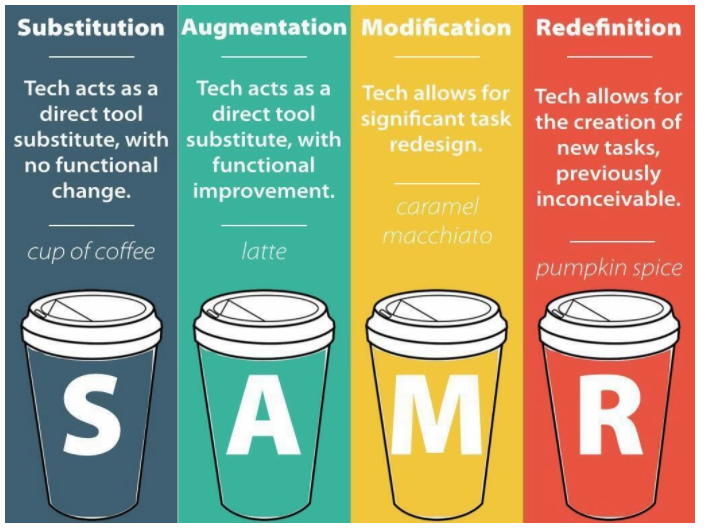Engaging the Online Learner - Pedagogy of Distance Learning
Practical Examples of the SAMR Model for 8 Different Lessons
November 16, 2020
"Following are 8 examples of the SAMR process, each taking an example of a typical classroom exercise that does not use technology and walking it through each phase of SAMR. For half of these, I searched and borrowed from examples that teachers had written about online (original sources are provided – in some cases I tweaked the example a bit). I also created examples of my own. In working through this, it became apparent to me that while Substitution and Augmentation can be relatively straightforward conceptually, there is even more room for interpretation when it comes to Modification and Redefinition."
Kelly Walsh, EmergingEdTech
Practical Examples of the SAMR Model
October 26, 2020
On the 3P Learning website, the SAMR model is explained with some great, practical examples.
Examples of substitution
- having students type their work instead of handwriting it
- using online quizzes and programs instead of pen and paper
- uploading a worksheet in PDF for student access, as opposed to photocopying
- using a digital interactive whiteboard as opposed to a traditional whiteboard and saving the results as a document.
Examples of augmentation
- Students give more informative and engaging oral presentations accompanied by a PowerPoint or Prezi containing multimedia elements.
- Students use the internet to independently research a topic, as opposed to relying on teacher input.
- Students use an EdTech program that gamifies curriculum content for student engagement and allows students to track progress in an accessible way.
- Teacher instruction is supplemented with a video that clarifies a particularly hard to explain concept.
Examples of modification
- Students produce podcasts summarizing a topic, which can then be accessed by other students as a revision resource.
- Students create an informative video presentation in place of a standard oral presentation. They can use their voice alongside a broader variety of creative multimodal components.
- Students use a technological tool that makes an abstract concept visible in a hands-on, responsive way (e.g. voyaging on Google Earth to better understand measurement and geography).
Examples of redefinition
- connecting your students with other people around the world as part of the learning journey
- having students publish their work online where it can be viewed by peers and the broader community
- recording students as they deliver a presentation or practice a physical skill, then using this recording to prompt student reflection
- experimenting with tasks that use extensive multimodal elements (e.g. producing documentaries or short films, webpages, print documents with creative layouts).
Applying the SAMR Model
October 5, 2020
The SAMR Model in Our Classrooms
September 17, 2020
Educational technology can really enhance teaching and learning for our students. However, it is a fair statement to say that not all educational technology is created equal. Some tools and practices are much more impactful than others. Dr. Ruben Puentedura, the founder and president of a consulting firm called Hippasus, developed the SAMR model to address how teachers select and implement educational technology in their classrooms. This model has 4 main levels to it: Substitution and Augmentation (which serve to Enhance instructional practice) and Modification and Redefinition (which serve to transform instructional practice).
For a peek into the SAMR model and what it looks like in schools, check out this YouTube video by John Spencer!




